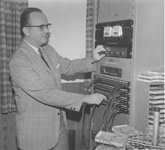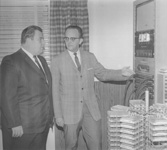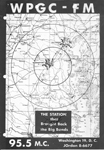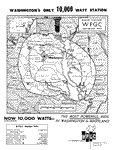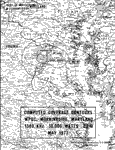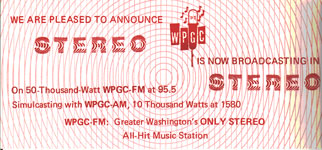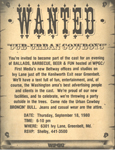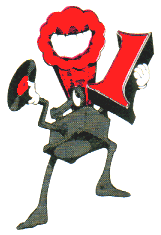
Engineering Related
Contact the Webmaster
Add this site to your Favorites
![]()
Air
Personalities
Morning
Shows
News
Guys
Money
Girls
Program
Directors
General
Managers
Sales
Types
Engineers
Other
Alumni
The
Good Guys Today
Radio
Heaven
Alumni
In The News
Alumni
Speak!
![]()
A
Brief History
Newspaper
Articles
Print
Advertisements
Press
Releases
Ratings
Like You Wish!
Weekly
Playlists
Photos
- People
Photos
- Promotions
Station
Logos
Bumperstickers
![]()
Airchecks
Newscasts
Sports
Reports
Traffic
Reports
Sound
Offs!
Commercials
Promos
Sweepers
Jingles
Misc.
Audio
![]()
Beatlemania
Collectibles
Contesting
Promotions
Sales
Related
Engineering
Stuff
WPGC
Sister Stations
The
Great Strike
Market
Competition
Other
Radio Tribute Sites
Oldies
Stations Today
Legendary
Air Performers
Special
Thanks
Mailbag
Home
Server space provided by:
Click
above to hear more vintage broadcast radio airchecks from the
Reel Radio Repository.
Your tax-deductible contribution to REELRADIO, Inc. will help keep this site online
This
site is in no way affiliated with WPGC Radio
today, or with
CBS Radio, Inc.
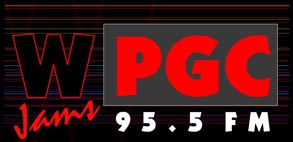 |
Click
above to visit WPGC today.
 |
Dedicated in memory of Jim Collins
 |
Tech Specs at a Glance
Prologue
In July 1922, Leslie L. Altman starts the Bradbury Heights Bus Line to Washington with 2 buses. Its garage & offices were located at 1510 Southern Avenue in SE, DC. In 1926 it incorporates as the Washington, Marlboro and Annapolis (WM&A) Motor Lines, Inc.
The bus line grows and on December 6, 1941 opens its new garage & office building at 4421 Southern Ave, SE, DC.
![]()
1947
The Federal Communications Commission grants a construction permit for a new FM station to the Chesapeake Broadcasting Company, Inc. in late 1947 to build and operate a station on 96.7 megacycles at Bradbury Heights, Maryland, "just over the District of Columbia line".
Furniture dealer Arthur Baldwin Curtis was President of Cheasapeake Broadcasting which selected and was granted WBUZ-FM as call letters for the 1KW station. By the end of the year, the station was authorized to use 420 watts Effective Radiated Power.
WBUZ-FM's transmitter and 255 foot tower were located at Bradbury Heights with studios & offices in the WM&A passenger terminal at 1510 Southern Ave. in SE, DC.

1948
The independent station originally announced a target date of Christmas, 1947 but delays caused by the failure of some equipment to arrive postponed WBUZ-FM's airdate to January 18th.
Treasurer & General Manager of WBUZ-FM was Leslie L. Altman, President of the WM&A Bus Line. Al K. Porter was Vice President & Commercial Manager of the new station, "the first all Gates-equipped station in the Washington, DC area".
Operating hour were from 7:00AM until 12 midnight daily. In late 1948, Leslie L. Altman was named President of the Chesapeake Broadcasting Co. while continuing as WBUZ-FM's General Manager.
![]()
1949
By early 1949, WBUZ-FM was 'transitcasting', programming recorded music into buses of the WM&A line. Another 'transitcaster in the DC area was WWDC-FM. Read a related story on 'transitcasting' here.
![]()
1950
The Chesapeake Broadcasting Co. is reorgnized. For a consideration of $1,300, 22.24% interest is acquired from A.C. Connelly by President & General Manager, Leslie L. Altman. The FCC sanctioned this transfer on August 14th, 1950.
![]()
1951
In June, 1951, the 'transitcasting' concept, in vogue over a number of independently operated FM stations across the United States, was attacked by the Transit Riders Association, and found unconstitutional by a Federal Appeals Court. The Chesapeake Broadcasting Company continues piping in WBUZ-FM into the Washington, Marlboro & Annapolis busses while the case was appealed.
The WBUZ-FM transmitter tower in Bradbury Heights is felled by vandals on October 13th, 1951. At the time, the WM&A Bus Line is the target of a labor dispute with its drivers. The station later returns to the air with 50 watts using a temporary antenna until a new tower can be erected and full power restored.
![]()
1952
The U.S. Supreme Court overturns a lower court and rules in favor of 'transitcasting' but the damage is done as the tide of public opinion has turned against riders of municipal transportation being forced to hear music and commercials against their will.
![]()
1953
WWDC stops 'transitcasting' (but now simulcasts WWDC-AM) in May 1953. But out of sheer economic necessity, WBUZ-FM with no sister AM station to fall back on, continues to broadcast to a total of 35 buses (out of a fleet of 90) of the WM&A line.
WBUZ-FM raises power to 6.3KW that same month and its city of license is changed to Oakland, Maryland. Then on June 8th, 1953, the FCC grants a permit to the station to raise power from 6.3KW to 18KW.
Meanwhile, on November 12th, 1953, Washington electronics engineer and former FCC employee, Harry Hayman receives a Construction Permit to build and operate a new Morningside, Maryland AM broadcasting station. The FCC assigns 250 watt daytime only operation to the station on 1580 kilocycles. Estimated construction cost $9,420; first year operating costs $28,140; anticipated first year advertising revenue $31,200. The call letters WPGC, representing Prince Georges County are issued late in the year.
![]()
1954
The tower for WPGC-AM is erected in April and broadcasts begin on April 24th, 1954 from Morningside on a hill on the farm of Duval B. Evans on Walters Lane. Harry Hayman is President & General Manager of the new independent station which airs 'Hillbilly Music' for 25% of its broadcast day. On September 15th, 1954, WPGC-AM's power is increased to 1,000 watts (250 watts Critical Hours).
Within 6 months of its on air debut, Maxwell Evans Richmond, purchases WPGC-AM from Harry Hayman for $10,000 on November 10th, 1954.
Also that year, WBUZ-FM, its 'transitcasting' days now behind it, changes frequency from 96.7 to 95.5 megacycles and power is reduced to 16.5KW from a new transmitter & tower site on Walker Mill Road in Oakland, MD, a few miles from Bradbury Heights.
![]()
1955
WBUZ-FM's President Leslie L. Altman names Leslie Smith as the new General Manager. WPGC-AM's President Maxwell Richmond names former WPGC-AM Chief Engineer, Gene Winters as General Manager of WPGC-AM that same year so that Richmond could devote more time to his advertising agency in Philadelphia as well as to WPGC's sister station in Boston, WMEX.
On April 14th, 1955 a modification of WPGC-AM's permit to raise power to 10,000 watts daytime only and install a directional antenna system was granted. Late in the year WPGC-AM opens new offices and studios at 4421 Southern Ave., SE, DC above the WM&A Bus Line repair facility, in the studios formerly used by WBUZ-FM (which has since moved it's studios to the transmitter site).
![]()
1956
On March 30th, 1956, WBUZ-FM changes its call letters to WRNC-FM. (Today the WBUZ calls are used by an alternative station in Nashville). Late in the year, WRNC-FM is purchased from the Chesapeake Broadcasting Company by WPGC, Inc. $5.00 is paid for the station license and $10,000 for its equipment and tower. FCC approval takes place on November 20th, 1956. The purchase is made to add nightime programming to WPGC-AM's daytime only operation.
At this time, WPGC-AM owner Maxwell Richmond becomes President of WRNC-FM and names Gene Winters, General Manager of WPGC-AM as General Manager of WRNC-FM. WRNC begins dupicating WPGC-AM's daytime programming immediately.
![]()
1958
WRNC-FM changes call letters to WPGC-FM in mid-March 1958. (Today the WRNC calls are assigned to an AM Country station not presently on the air in suburban Atlanta). Power on the FM is reduced to 15.7KW while the power increase authorized for the AM in 1955 to 10,000 watts daytime only is implemented. The FM temporarily goes silent as new studios in preparation for a new format are constructed at the transmitter site.
![]()
1959
In February 1959, the FM returns to the air from new studios at the transmitter site at 6369 Walker Mill Road in Oakland, MD, playing Big Band music. Robert Howard joins the station early in the year as its new General Manager. On July 2nd, 1959, the FCC authorizes the station to mount the FM antenna on the north (280 foot) tower of the AM's array.
By this time, the Washington, Marlboro & Annapolis Bus Line is sold to an employee group and founder Leslie L. Altman retires to Florida.
![]()
1964
On January 27th, 1964, the FM is granted FCC authorization to change its city of license from Oakland to Morningside. The FM begins expanded broadcasts till midnight beyond the AM sign-off time.

1965
On June 28th, 1965, the stations are granted a modification of their licenses to move studios to Bladensburg, MD (outside the city limits of Morningside but are allowed to continue to identify themselves as being in Morningside). New offices & studios are located in the Parkway Building adjacent to the Baltimore Washington Parkway, 5801 Annapolis Road, Landover Heights (adjacent to Bladensburg), occupying the top floor of a multi story office building which open late in the year.
1968
The FM is granted a construction permit to raise power to 50KW on August 6, 1968. Coinciding with this, the FM begins its first 24 hour broadcasts, also in August.
![]()
1969
The raise in power for the FM to 50KW authorized in 1968 is implemented, utilizing two transmitters in parallel.
![]()
1972
The FM goes ((Stereo))!!
![]()
1973
The Washington Metropolitan Area Transit Authority (WMATA) purchases the Washington, Marlboro & Annapolis bus line (WM&A, original owner of WBUZ-FM) for $4.5 million. Along with the near simultaneous acquisition of the other three independently owned bus lines in the greater Washington area, MetroBus is formed.
![]()
1974
Foreshadowing things to come, ratings on the FM surpass those on the AM for the first time. For years, the station has continually conditioned its listeners to 'tune over now' at sunset.
Meanwhile, the estate of station owner, Max Richmond receives FCC approval on August 7th, 1974 to sell the stations for $5.8 million to First Media Corporation (Richard E. Marriott, Chairman & 44% owner). The transaction is finalized on October 17, 1974. Outbid for the properties, General Manager Bob Howard exercises his right of first refusal, leaves the station and purchases WYSL in Buffalo. First Media Corporation names Glenn Potter as President and GM.
![]()
1975
A new FM transmitter is installed late in 1975 concurrent with a boost in antenna height to 480 feet (horizontal & vertical polarization).

1976
Market motion: Ratings on the Washington FM dial as a whole surpass those for AM stations for the first time, making DC the first FM dominant market in the country, thanks in no small part to WPGC's long time campaign to convert cume to FM.
![]()
1979
On April 9th, 1979 the FCC grants the AM a permit to raise power from 10KW to 50KW, still daytime only, directional.
![]()
1980
After 15 years in the Parkway Building in Bladensburg, the station moves to new state of the art studios overlooking the Beltway in Greenbelt at 6301 Ivy lane, Suite 800. Charles Giddens is named the new General Manager when the venerable Bill Prettyman leaves for station ownership on Maryland's Eastern Shore.
![]()
1981
On June 18th, 1981 authorization from the FCC is granted to change the transmitting location from 6369 Walker Mill Road to 5526 Walker Mill Road. The change of sites occurs on December 21, 1981. The FM's antenna height is increased to 500 feet.
![]()
1984
On September 13th, 1984 the FCC renews the permit to raise power on the AM from 10KW to 50KW.
![]()
Epilog:
First Media decides to sell all of its properties for $177 million to a minority interest in early 1987. New owners Cook Inlet promptly rebuild the station as Urban Contemporary and bring back the legendary call letters on May 30th, 1987. Ratings rise almost immediately, softening the blow somewhat of unquestionably the biggest blunder in the history of Washington radio at that time.
Eventually the AM raises power from 10KW to 50KW watts in late 1986 and debuts a business talk format in 1988. In October 1987, it also gains a low power nightime authorization of 270 watts. In 1989 the AM's nightime power is increased to 500 watts directional, but a change in the directional pattern in 1990 requires a reduction in power back to 270 watts.
Infinity Broadcasting acquires the stations from Cook Inlet in June 1994 for $60 million. The stations move to new studios and offices at 4200 Parliament Place, Suite 300 in Lanham, MD in the Summer of 2000 where they remained until relocating to the the District in 2015.
|
Photos
Print Materials
Sound Files Miscellaneous Audio
Miscellaneous Studio & Transmitter Locations
|
![]()
|
Small Print Dept.: This non-profit historical site is not affiliated in any way with WPGC Radio today or CBS Radio, Inc. Use of copyrighted material is consistent with the "fair use" provisions contained in §107 of the Copyright Act of 1976 due to the following characteristics: Use of copyrighted material is of a nonprofit, educational nature, intended for the sole purposes of research and comment and does not significantly negatively affect "the potential market for or value of the copyrighted work(s)." Use of registered trademark material is not subject to civil action or injunction as outlined in §1114 and §1125 of the Trademark Act of 1946 (the Lanham Act) due to the following characteristics of this work, and the registered marks published herein: Use of reproductions of registered marks is not for the purpose of commerce, nor is the use connected with the sale, offering for sale, or advertising of any goods or services. Use of reproductions is not likely to cause confusion, mistake, or deception as to the affiliation, connection, or association of this work with owners of published registered marks, nor as to the origin, sponsorship, or approval of this work by owners of published registered marks. Wherever possible, the copyright or registered mark owner's name has been noted near the copyrighted work or registered mark; however, all material used in this site, including, but not limited to, newspaper articles, syndicated themes, promos, commercials, photographs, playlists, press releases, ratings, airchecks, newscasts, traffic reports, sports reports, 'sound-offs', sweepers, bumperstickers and station logos, should be considered protected copyrighted material or registered mark with all rights reserved to the owner, named or unnamed. So there! |
